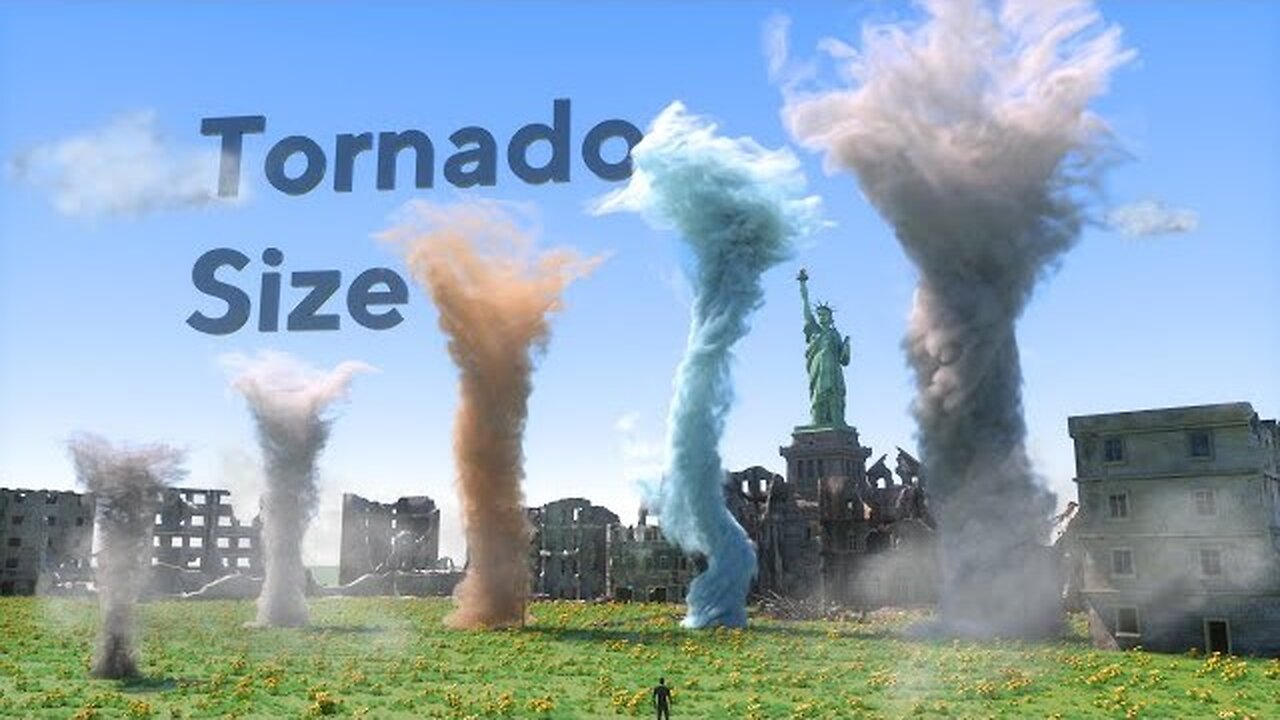Premium Only Content

Tornado Size Comparison
Use headphones for the best experience ;)
#tornado #size
A tornado is a rapidly rotating column of air that is in contact with both the surface of the Earth and a cumulonimbus cloud or, in rare cases, the base of a cumulus cloud. The windstorm is often referred to as a twister, whirlwind or cyclone,although the word cyclone is used in meteorology to name a weather system with a low-pressure area in the center around which winds blow counterclockwise in the Northern Hemisphere and clockwise in the Southern. Tornadoes come in many shapes and sizes, and they are often visible in the form of a condensation funnel originating from the base of a cumulonimbus cloud, with a cloud of rotating debris and dust beneath it. Most tornadoes have wind speeds less than 110 miles per hour (180 km/h), are about 250 feet (80 m) across, and travel a few miles (several kilometers) before dissipating. The most extreme tornadoes can attain wind speeds of more than 300 miles per hour (480 km/h), are more than two miles (3 km) in diameter, and stay on the ground for dozens of miles (more than 100 km).
Various types of tornadoes include the multiple vortex tornado, land spout and waterspout. Waterspouts are characterized by a spiraling funnel-shaped wind current, connecting to a large cumulus or cumulonimbus cloud. They are generally classified as non-super cellular tornadoes that develop over bodies of water, but there is disagreement over whether to classify them as true tornadoes. These spiraling columns of air frequently develop in tropical areas close to the equator, and are less common at high latitudes. Other tornado-like phenomena that exist in nature include the gustnado, dust devil, fire whirls, and steam devil.
Tornadoes occur in North America, particularly in the area of the United States known as tornado alley,as well as in northern and east-central South America, Southern Africa, northwestern and southeast Europe, western and southeastern Australia, and New Zealand.Tornadoes can be detected before or as they occur through the use of Pulse-Doppler radar by recognizing patterns in velocity and reflectivity data, such as hook echoes or debris balls, as well as through the efforts of storm spotters.
There are several scales for rating the strength of tornadoes. The Fujita scale rates tornadoes by damage caused and has been replaced in some countries by the updated Enhanced Fujita Scale. An F0 or EF0 tornado, the weakest category, damages trees, but not substantial structures. An F5 or EF5 tornado, the strongest category, rips buildings off their foundations and can deform large skyscrapers. The similar TORRO scale ranges from a T0 for extremely weak tornadoes to T11 for the most powerful known tornadoes. Doppler radar data, photogrammetry, and ground swirl patterns (cycloidal marks) may also be analyzed to determine intensity and assign a rating.
-
 25:09
25:09
Jasmin Laine
16 hours agoReporter CATCHES Carney Red-Handed—Liberal MP SNAPS in Public MELTDOWN
1.25K28 -
 9:05
9:05
Adam Does Movies
14 hours agoIT: Welcome To Derry Episode 3 - Recap
260 -
 14:43
14:43
Producer Michael
17 hours agoBILLION DOLLAR GOLD MOGUL'S PRIVATE WATCH COLLECTION
108 -
 38:44
38:44
State of the Second Podcast
17 hours agoThe Mini Gun Brand Everyone’s Talking About (ft. Goat Guns)
801 -
 9:59
9:59
TheSaltyCracker
14 hours agoBerkeley Communists Rob & Attack Man Outside TPUSA Event
59.1K164 -
 36:09
36:09
ZeeeMedia
14 hours agoFauci-Era Animal Experiments Continue, Texas New Push for Digital ID | Daily Pulse Ep 141
16K13 -
 2:10:12
2:10:12
Side Scrollers Podcast
19 hours agoMAJOR Hasan Allegations + Arc Raiders Review CONTROVERSY + Craig TRENDS on X + More | Side Scrollers
128K20 -
 9:24
9:24
MattMorseTV
17 hours ago $12.96 earnedFetterman is actually DOING IT...
16.6K47 -
 49:23
49:23
Live From The Casita
9 hours ago $5.01 earnedLive Music Jam
18.7K4 -
 2:55:50
2:55:50
The Pascal Show
14 hours ago $1.86 earnedMASSIVE CHAOS?! Transportation Secretary Hold Presser On Air Travel & More
13.1K2